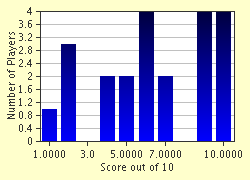Quiz Answer Key and Fun Facts
1. Talking Heads established themselves with their debut album 'Talking Heads: 77'; released (perhaps somewhat unsurprisingly) in 1977. Which track, one of the band's most enduring hits, contains many lyrics in French as the title figure tries to "realisant mon espoir" whilst continuously asking "qu'est-ce que c'est"?
2. Less than a year after '77', Talking Heads released their second album. What substance completes the title of 'More Songs About Buildings and...'?
3. Which track, a cover of an Al Green song from 1974, did lead singer David Byrne describe as "A song that combines teenage lust with baptism. Not equates, you understand, but throws them in the same stew, at least. A potent blend."?
4. Talking Heads' third studio album, 'Fear of Music', was released in 1979. Which song, which had it's origins in a jamming session, was subtitled 'This Ain't No Party... This Ain't No Disco... This Ain't No Foolin' Around'?
5. Perhaps you're wondering why this quiz is called 'This is Not My Beautiful House!'? This is a lyric from one of Talking Heads' biggest hits. In which song from 1980's 'Remain in Light' can it be found?
6. The first song on 'Remain in Light' is 'Born Under Punches (The Heat Goes On)'. To which part of his body does the singer repeatedly implore us to "take a look at" in the lyrics of this song?
7. While many additional musicians assisted with live performances, four core members stayed with the band for the entirety of their recording career. They were David Byrne, Chris Frantz, Jerry Harrison and which bassist?
8. After releasing four studio albums in as many years, Talking Heads took a well-deserved break in the early 1980s and decided to go on tour. Which 1982 live album contains material both from this tour and some of their earlier concerts?
9. Capturing a combination of three shows in Los Angeles in 1983, which live album is the soundtrack to a film of the same name directed by Jonathan Demme?
10. Talking Heads only top 10 hit in both the United States Billboard Hot 100 and the Canadian Singles Chart was 1983's 'Burning Down the House'. On which studio album, the band's first for three years, can it be found?
Source: Author
pagea
This quiz was reviewed by FunTrivia editor
1nn1 before going online.
Any errors found in FunTrivia content are routinely corrected through our feedback system.

